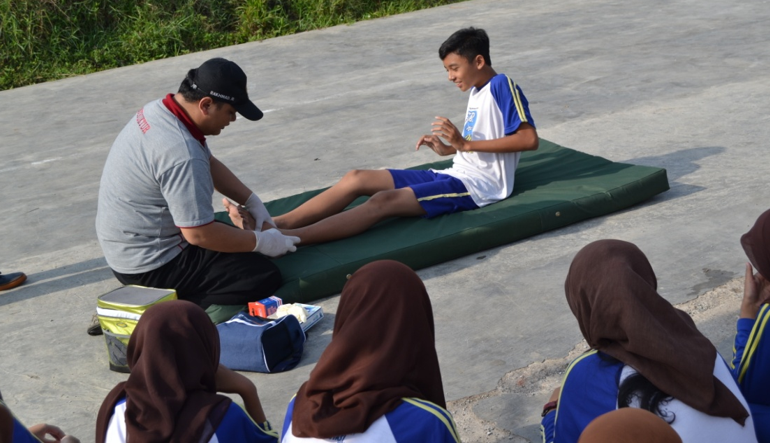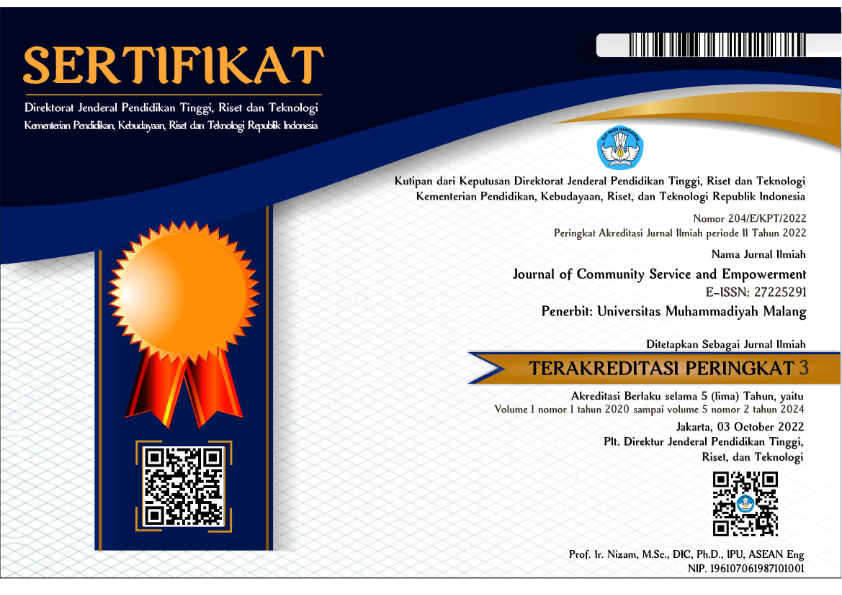Management of sport injury using the concept of "do rice, don't harm"
DOI:
https://doi.org/10.22219/jcse.v3i1.16509Keywords:
Community service, School health unit, Sports injuryAbstract
Increasing physical capacity or performance after injury to students is a procedure that is in accordance with the commitment to achieving the Sustainable Development Goals (SDGs) in the health sector. This service activity aims to increase the active participation of teachers and students in overcoming sports injury health problems. The approach method used in this service activity is to use a synergistic partnership improvement to increase the participation of partners. The approach was carried out with the school health unit (Unit Kesehatan Sekolah/UKS) officers and students. The implementation of this activity received positive support from the principal and sports teachers and is an activity that has never been done in this place. This activity is the result of collaboration between the Faculty of Health Sciences UMM and SMPN 26 Malang City. Based on the results of the evaluation of the training activities carried out, it was found that the participants were able to take part in this activity well and enthusiastically as indicated by an increase in knowledge of 75%. This means that there is an increase in the active participation of teachers and students in overcoming sports injury health problems.
Downloads
References
Abernethy, L., MacAuley, D., McNally, O., & McCann, S. (2003). Immediate care of school sport injury. Injury Prevention, 9(3), 270–273.
Andreoni, V., & Miola, A. (2016). Competitiveness and Sustainable Development Goals (Issue January). European Commission. https://doi.org/10.2788/64453
BAPPENAS. (2019). Emerging findings for reaching the targets. BAPPENAS.
Emery, C. A., & Pasanen, K. (2019). Current trends in sport injury prevention. Best Practice & Research Clinical Rheumatology, 33(1), 3–15.
Fery Fadly, & Fadilla, S. P. (2020). Rancangan basis data sistem informasi usaha kesehatan sekolah. Techno Xplore : Jurnal Ilmu Komputer Dan Teknologi Informasi, 5(2), 49–55. https://doi.org/10.36805/technoxplore.v5i2.1130
Heaney, C. A., Rostron, C. L., Walker, N. C., & Green, A. J. K. (2017). Is there a link between previous exposure to sport injury psychology education and UK sport injury rehabilitation professionals’ attitudes and behaviour towards sport psychology? Physical Therapy in Sport, 23, 99–104.
Hidayat, K., & Argantos, A. (2020). Peran usaha kesehatan sekolah (UKS) sebagai proses prilaku hidup bersih dan sehat peserta didik. Jurnal Patriot, 2(2), 627–639.
Levinger, P., Menz, H. B., Wee, E., Feller, J. A., Bartlett, J. R., & Bergman, N. R. (2011). Physiological risk factors for falls in people with knee osteoarthritis before and early after knee replacement surgery. Knee Surgery, Sports Traumatology, Arthroscopy, 19(7), 1082–1089.
Lun, V., Marsh, A., Bray, R., Lindsay, D., & Wiley, P. (2015). Efficacy of hip strengthening exercises compared with leg strengthening exercises on knee pain, function, and quality of life in patients with knee osteoarthritis. Clinical Journal of Sport Medicine, 25(6), 509–517.
McGlashan, A. J., & Finch, C. F. (2010). The extent to which behavioural and social sciences theories and models are used in sport injury prevention research. Sports Medicine, 40(10), 841–858.
Meikahani, R., & Kriswanto, E. S. (2015). Pengembangan buku saku pengenalan pertolon gan dan perawatan cedera olahraga untuk siswa sekolah menengah pertama. Jurnal Pendidikan Jasmani Indonesia, 11(1).
Putra, F. L., & Wahyuni, E. S. (2018). Survei kelayakan program usaha kesehatan sekolah (UKS) di sekolah menengah atas se-Kabupaten Lamongan. Jurnal Pendidikan Olahraga Dan Kesehatan, 6(1), 191–197.
Rosadi, R. (2021). Analisis resiko neck pain pada operational hauling bagian operator alat berat PT. Mutiara Tanjung Lestari di Tanjung Redeb, Kab. Berau. Jurnal Sport Science, 11(1), 35–40.
Rosadi, R., Mabrur, A., & Wardojo, S. S. I. (2021). Pelaksanaan Fisioterapi Komunitas Dalam Upaya Meningkatkan Kesadaran Tentang Cedera Olahraga Pada Pemain Bola Voli Putri Generasi Muda Juata Laut. Jurnal Pengabdian Masyarakat IPTEKS, 7(2), 242–246.
Rosadi, R., Sunaringsih, S., Wardojo, I., & Fisioterapi, P. S. (2019). Perbandingan efektivitas retrowalking dan quadricep strengthening exercise terhadap peningkatan activity of daily living pada lansia yang terkena osteoartrithis knee di Puskesmas Kendal Kerep Kota Malang. Jurnal Fisioterapi Dan Rehabilitasi (JFR), 3(1), 72–78.
Rosadi, R., & Wardojo, S. S. I. (2017). Analysis of physiotherapy service potential based on disease case, economy and social at the UMM Hospital. Research Journal of Medicinal Sciences, 11(1), 77–80. https://doi.org/10.36478/rjmsci.2017.77.80
Sanusi, R., Surahman, F., & Yeni, H. O. (2020). Pengembangan Buku Ajar Penanganan dan Terapi Cedera Olahraga. Journal Sport Area, 5(1), 40–50.
Susana, A. (2018). Manajemen kesehatan peserta didik sekolah dasar. Jurnal Administrasi Pendidikan, 25(1), 65–79.
Susko, A. M., & Fitzgerald, G. K. (2013). The pain-relieving qualities of exercise in knee osteoarthritis. Open Access Rheumatology: Research and Reviews, 5, 81.
WHO. (2017). Monitoring the Health-Related Sustainable Development Goals ( SDGs ). February, 9–10.

Downloads
Published
How to Cite
Issue
Section
License
Copyright (c) 2022 Rakhmad Rosadi, Sri Sunaringsih Ika Wardojo

This work is licensed under a Creative Commons Attribution-ShareAlike 4.0 International License.












